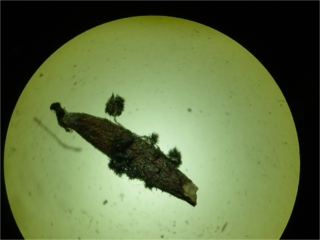
In physics, the kinetic energy of an object is the form of energy that it possesses due to its motion.

In Newtonian mechanics, momentum is the product of the mass and velocity of an object. It is a vector quantity, possessing a magnitude and a direction. If m is an object's mass and v is its velocity, then the object's momentum p is:

In biochemistry, Michaelis–Menten kinetics, named after Leonor Michaelis and Maud Menten, is the simplest case of enzyme kinetics, applied to enzyme-catalysed reactions of one substrate and one product. It takes the form of a differential equation describing the reaction rate to , the concentration of the substrate A. Its formula is given by the Michaelis–Menten equation:
Pyrenophora teres is a necrotrophic fungal pathogen of some plant species, the most significant of which are economically important agricultural crops such as barley. Toxins include aspergillomarasmine A and related compounds.
The cereal grain wheat is subject to numerous wheat diseases, including bacterial, viral and fungal diseases, as well as parasitic infestations.

The fungus Cochliobolus sativus is the teleomorph of Bipolaris sorokiniana (anamorph) which is the causal agent of a wide variety of cereal diseases. The pathogen can infect and cause disease on roots, leaf and stem, and head tissue. C. sativus is extremely rare in nature and thus it is the asexual or anamorphic stage which causes infections. The two most common diseases caused by B. sorokiniana are spot blotch and common root rot, mainly on wheat and barley crops.
Spot blotch is a leaf disease of wheat caused by Cochliobolus sativus. Cochliobolus sativus also infects other plant parts and in conjunction with other pathogens causes common root rot and black point.

The fungal genus Pyrenophora includes 108 species, including the following plant pathogenic species: Pyrenophora teres, Pyrenophora graminea and Pyrenophora tritici-repentis.

Pyrenophora graminea is the causal agent of barley stripe. Barley stripe is disease of barley that once caused significant crop yield losses in many areas of the world. Its associated anamorph is Drechslera graminea(Rabenhorst ex Schlechtendal) S. Ito 1930.

Pyrenophora tritici-repentis (teleomorph) and Drechslera tritici-repentis (anamorph) is a necrotrophic plant pathogen of fungal origin, phylum Ascomycota. The pathogen causes a disease originally named yellow spot but now commonly called tan spot, yellow leaf spot, yellow leaf blotch or helminthosporiosis. At least eight races of the pathogen are known to occur based on their virulence on a wheat differential set.

Pyrenophora seminiperda is a minor plant pathogen that causes leaf spots on many grasses. It is an important generalist grass seed pathogen which causes visible cylindrical masses of black fungal hyphae (stromata) to grow from infected seeds. Hence the common name "black fingers of death"
Pyrenophora avenae is a species of fungus in the family Pleosporaceae. It is a plant pathogen, causing leaf stripe, blotch or spot and seedling blight of oats.
Pyrenophora teres f. maculata is a plant pathogen causing spot form net blotch in barley.

Pleosporaceae is a family of sac fungi. They are pathogenic to humans or saprobic on woody and dead herbaceous stems or leaves.
Clathrospora is a genus of fungi in the family Diademaceae. The widespread genus contained five species in 2008, the genus increased to 20 species by 2023.

Aspergillomarasmine A is an polyamino acid naturally produced by the mold Aspergillus versicolor. The substance has been reported to inhibit two antibiotic resistance carbapenemase proteins in bacteria, New Delhi metallo-beta-lactamase 1 (NDM-1) and Verona integron-encoded metallo-beta-lactamase (VIM-2), and make those antibiotic-resistant bacteria susceptible to antibiotics. Aspergillomarasmine A is toxic to leaves of barley and other plants, being termed as "Toxin C" when produced by Pyrenophora teres.
Black point is often considered a fungal disease that affects wheat, barley and rye. It is thought to be caused by various species of Alternaria, Fusarium, and Helminthosporium, and possibly other fungal genera. The fungus forms after the seeds have set but while they are still green and it is potentiated by high humidity. Infected areas are brown to black in color, and as the disease spreads the kernels may become shriveled. Occasionally the infected areas have a reddish tinge.

Augusto Napoleone Berlese was an Italian botanist and mycologist. He was the brother of entomologist Antonio Berlese 1863–1927, with whom he founded the journal Rivista di patologia vegetale in 1892.

Prochloraz, brand name Sportak, is an imidazole fungicide that was introduced in 1978 and is widely used in Europe, Australia, Asia, and South America within gardening and agriculture to control the growth of fungi. It is not registered for use in the United States. Similarly to other azole fungicides, prochloraz is an inhibitor of the enzyme lanosterol 14α-demethylase (CYP51A1), which is necessary for the production of ergosterol – an essential component of the fungal cell membrane – from lanosterol. The agent is a broad-spectrum, protective and curative fungicide, effective against Alternaria spp., Botrytis spp., Erysiphe spp., Helminthosporium spp., Fusarium spp., Pseudocerosporella spp., Pyrenophora spp., Rhynchosporium spp., and Septoria spp.










